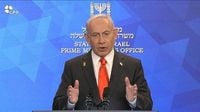For the first time in nearly two years of brutal conflict, a fragile but potentially transformative pause has settled over the Gaza Strip. On October 5, 2025, the Israel Defence Forces (IDF) ordered a halt to offensive operations and shifted to heightened standby, marking the start of a U.S.-brokered plan aimed at securing the release of hostages and laying groundwork for a possible end to the war. The move came after intense overnight consultations between IDF Chief of General Staff Lieutenant-General Eyal Zamir and U.S. officials, with the army emphasizing that the safety of soldiers remains paramount and that all units remain deployed for protection and rapid response if necessary, according to the IDF press service (as reported by BBC and Associated Press).
This significant pause follows the unveiling of a 20-point ceasefire and postwar framework by U.S. President Donald Trump. The proposal, which Trump announced earlier in the week alongside Israeli Prime Minister Benjamin Netanyahu, calls for an immediate cessation of fighting if both Israel and Hamas accept its terms. Under the plan, Hamas would release all remaining hostages—reportedly around 48, with about 20 believed alive—within 72 hours of Israel’s acceptance. In return, Israel would halt its offensive, withdraw from much of the territory, release hundreds of Palestinian prisoners (including women and children detained since the October 7, 2023 attacks), and allow an influx of humanitarian aid and eventual reconstruction. The plan also stipulates that no one in Gaza would be forced to leave, shelving earlier ideas about relocating much of the population.
Trump did not mince words about the stakes. “If this LAST CHANCE agreement is not reached, all HELL, like no one has ever seen before, will break out against Hamas,” he posted on social media, setting a public deadline of 6 p.m. Eastern Time on Sunday, October 5, 2025 (02:00 a.m. on October 6, GMT+4), for Hamas to agree to the deal. He further warned, “I will not tolerate delay, which many think will happen, or any outcome where Gaza poses a threat again. Let’s get this done, fast. Everyone will be treated fairly!” (as quoted by India Today and Associated Press).
Hamas, for its part, has signaled a mixed but cautiously positive response. On October 3, 2025, the group announced its willingness to release the hostages and hand over power to other Palestinians, though it emphasized that further consultations were needed on other aspects of the plan, particularly those touching on the future governance of Gaza and Palestinian rights. Senior Hamas official Mousa Abu Marzouk explained to Al Jazeera that “the proposal cannot be implemented without negotiations,” and noted that it might be difficult to locate all hostages’ remains within the 72-hour deadline. Another official, Osama Hamdan, told Al Araby television that Hamas would refuse foreign administration of Gaza and that the entry of foreign forces would be “unacceptable.”
The plan’s political aftershocks have reverberated across the region and the world. International reactions have been enthusiastic, with European and Middle Eastern leaders expressing hope that the proposal could finally end the deadliest conflict involving Israel since its founding in 1948. Egypt welcomed Hamas’s initial acceptance, calling it a sign that Palestinians want to “end a dark period in the history of the region” and pave the way for a future state—though Israel has long opposed such an outcome. Iran-backed Palestinian Islamic Jihad, a smaller but hardline group that also holds hostages, endorsed Hamas’s response, potentially smoothing the path for a more comprehensive release of captives.
Yet, obstacles remain. Within Israel, political divisions have surfaced, with key ministers Itamar Ben-Gvir and Bezalel Smotrich dismissing Netanyahu’s support for the peace plan. Meanwhile, Hamas accused Netanyahu of “lying” about reducing Israeli military operations—a precondition for the release of hostages. On the ground, violence and uncertainty persist. On October 4, 2025, 10 people were killed in a fresh Israeli airstrike in Gaza City, even as Israeli forces shifted from offensive to defensive maneuvers. Al-Shifa Hospital director Mohamed Abu Selmiyah told The Associated Press that Israeli strikes had “significantly subsided,” but gunfire and explosions have continued to rock Gaza City, followed by unsettling silence, as reported by Sky News.
The human toll of the conflict has been staggering. According to Gaza’s Health Ministry, more than 66,000 Palestinians have been killed since Israel launched its retaliatory offensive after the October 7, 2023, Hamas-led attacks that killed around 1,200 people in Israel and resulted in 251 hostages. Women and children reportedly make up about half of the Palestinian casualties. The offensive has displaced around 90% of Gaza’s population—roughly 2 million people—leaving much of the territory uninhabitable. Olga Cherevko, a spokesperson for the U.N. humanitarian office, described seeing families living in the parking lot of Shifa Hospital because they could not afford to move south. “One of the families had three children and the woman was pregnant with her fourth. And there were many other vulnerable cases there, including elderly people and people with disabilities,” she told The Associated Press.
Despite the devastation, the prospect of a ceasefire and the return of hostages has injected a rare note of optimism. Israeli Prime Minister Netanyahu delivered a “victorious” speech, promising, “We will bring all the hostages home,” and signaling Israel’s readiness for the “immediate implementation” of the first stage of Trump’s plan. The White House, meanwhile, announced that Trump was dispatching envoys Steve Witkoff and Jared Kushner to Egypt to finalize technical details regarding the hostage release and to discuss a lasting peace deal.
Still, the plan’s most controversial elements remain unresolved. The framework envisions a temporary governing board for Gaza, chaired by Trump and joined by figures including former British Prime Minister Tony Blair, and places the territory under international governance—at least for now. Notably, it provides no path for eventual reunification with the Israeli-occupied West Bank, a longstanding Palestinian aspiration. Many Palestinians, while desperate for an end to the war, view the proposal as heavily skewed in Israel’s favor and are wary of foreign oversight.
The coming hours and days are critical. If Hamas confirms the deal by the deadline, a ceasefire could take immediate effect, hostages could begin to return home, and the region might finally see the first steps toward stability after years of bloodshed. But if the plan falters—if trust breaks down or any party reneges on its commitments—the IDF has made clear that it stands ready to resume operations at a moment’s notice. For now, the world watches and waits, holding its breath as history hangs in the balance.



